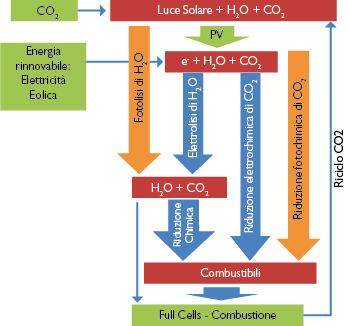CHEMISTRY AND ENERGY





At International level, the research in the energetic field is more and more conditioned by the climate and environmental changes caused by the use of fossil fuels that push it towards a low carbon economy and use of renewables. In this vision, a major role is going to play the Energy Union through the Paris Agreement signed during the COP21 Meeting, where the environmental friendly energy production is accompanied by the development of innovative energy storage systems (electrical, chemical and thermal) and by more effective ways of energy efficiency to push the decarbonisation of the global, and therefore national energy system. It is therefore necessary to change the energy paradigm, not only promoting the renewables penetration, but also considering a progressive decarbonisation of the fuels focusing the efforts towards biofuels and alternative ones, such as hydrogen, and considering at the same time the CO2 capture and utilization.
In this scenario, chemistry and materials science play an important role, recognized also by the International Energy Agency (IEA) in its strategic and analytical documents, for understanding the mechanisms, and for the design and up-scaling of processes and products able to shift the energetic system from a fossil fuel- based one towards a new paradigm more respectful of the environment and the human beings assuring, at the same time, the same quality of life achieved (or that is going to be achieved).
The DSCTM activities in this respect are focused on four main themes:
- solar fuels and CO2 utilization
- Third and Forth Generation Photovoltaics (organic and hybrid)
- Hydrogen and fuel Cells
- Processes and technologies for biomass exploitation
- solar fuels and CO2 utilization
- Third and Forth Generation Photovoltaics (organic and hybrid)
- Hydrogen and fuel Cells
- Processes and technologies for biomass exploitation
The importance of material science and chemistry for developing efficient and sustainable devices in each of these areas is strong and evident. For the solar fuels, the activities comprises all the different mechanisms (and therefore devices) by which water and carbon dioxide, pursuing the dream of artificial photosynthesis, can be convert in fuels: from the water electrolysis or co-electrolysis with carbon dioxide using renewable energy, up to their photocatalytic conversion.


For the former, several DSCTM’s groups consider the high or low temperature conversion focusing on the production of nanostructured systems eventually with catalytic properties. For the latter on the other hand, the activities are more linked to the development of photochemical or catalytic systems (homogenous and heterogeneous) for water splitting and the reaction with CO2; to the identification of organic, metallorganic or hybrid systems for the light capturing (antennas) and production of semiconductors layers, backbones of the photoelectrochemical cells (PEC); and to the production and validation of the final devices. High level ab-initio modelling and technologies for photochemical, microstructural and structural characterization contribute in building a well structured and multidisciplinary area of research. It is important to notice that the largest part of the mechanistic studies, is nowadays sustained by the computational modelling, for its ability to identify reaction mechanisms and intermediates that cannot be detected experimentally. These powerful tools can be used to optimize the device efficiency and selectivity. Along with the study of single elements there are several activities on the growth and deposition of films via self-assembly and supramolecular approaches, as well as the chemical and physical deposition of highly engineered nanosystems. Technologies of capture (MOF, inorganic systems, etc.) and separation (membranes) of carbon dioxide and hydrogen from gas mixtures (either at low and high temperature) are fundamental ancillary systems to convert the carbon dioxide from waste to a valuable raw material.
In the field of third and fourth generation photovoltaics, the activities are focused on the deep study of the material chemistry and of the production and deposition processes aided by the mechanistic studies of the exitonic and electronic phenomena involved. Prominent activities are linked to the development of (i) Organic photovoltaics (OPV) with studies on the influence either of small molecules or polymers, of efficient, large scale and low cost production techniques and of multilevel efficiency control; (ii) Dye sensitized solar cells (DSSCs) with studies on modelling, on the development of new materials and deposition techniques, on innovative dyes and on advanced characterization techniques.
Important activities are related to the modelling; and materials of organic halide perovskites.
The Hydrogen economy is comprehensively considered, from the production to storage and use as energy vector. International groups deal with the study of homogeneous and heterogeneous catalysts and electrocatalysts for low temperature fuelled cells (PEM, DA) and of materials and components for high temperatures one (SOFC). Other than the single elements or material, several activities are related to the up-scaling and characterization of pre-competitive cells.
Finally, other than the chemical storage (solar fuels) the DSCTM activities on energy storage are related to the thermal one (Phase change materials, nanofluids and high temperature absorbers), and heating and cooling whereas on the electrochemical storage, researches are focused on alternative systems to the lithium-based batteries and on the recovery of value materials from these latters.
Of absolute excellence with international leadership, the projects related to the new generation of low cost, large area flexible lighting fully integrated in intelligent systems.
The energy from biomasses is focused on the biofuels, in particular on processes based on “ad hoc biomasses” growth on marginal or arid lands and from agricultural waste. The use of these materials and of well designed chemical process lead to high quality, low costs biofuels. From these characteristics is easily to forecast a strategic importance of new processes for the production of biodiesel. Important activities are related to the production of bio-hydrogen produced by extremophiles bacteria.





